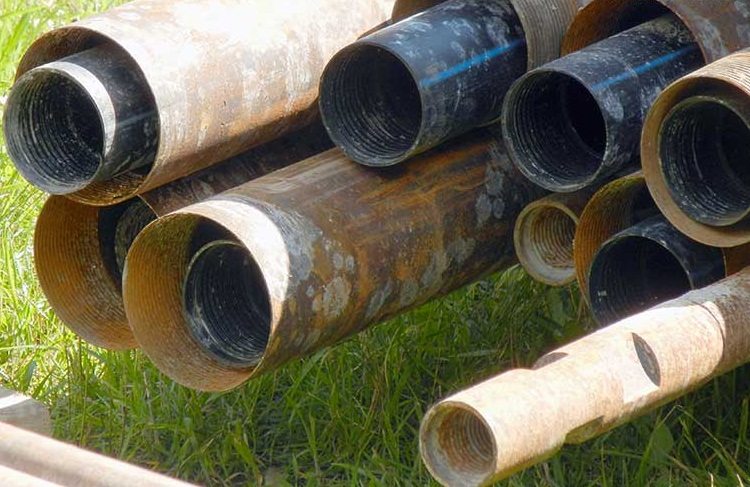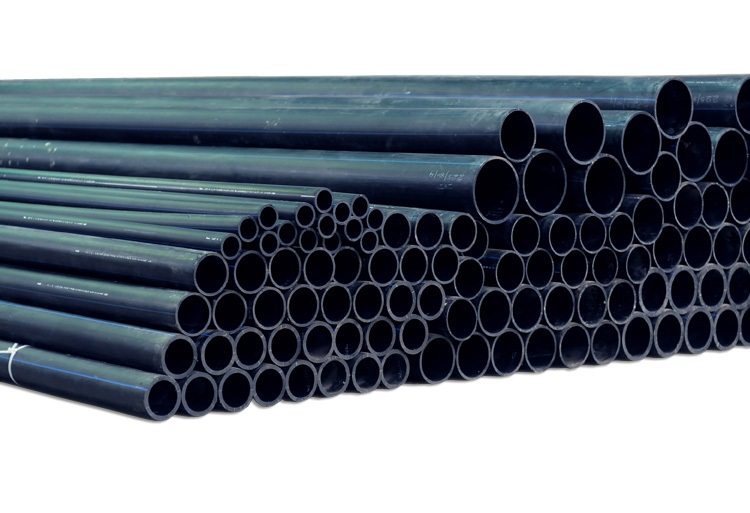Among the whole variety of industrial pipes, casings made of HDPE are important. Quite high requirements are imposed on this type of structures, since they are important when drilling oil and gas wells, when searching for water, minerals, etc. Pipes are lowered into them so that the walls can withstand rock layers and prevent them from crumbling.

HDPE pipes do not impair water quality, therefore they are used for casing of household and household wells
Content
- 1 Materials from which casing elements are made
- 2 Technical Overview
- 3 Well preparation for pipes
- 4 Features of PND products
- 5 The main dimensions of HDPE pipes for wells
- 6 PND pipe diameter selection
- 7 How to connect casing HDPE
- 8 Rules for the use of polyethylene elements
- 9 Installation of a water-lifting PND pipe with a pump
Materials from which casing elements are made
Three materials can be used for casing production:
- steel;
- asbestos cement;
- plastic.
Steel pipe is characterized by very high strength. The connection of structural elements is carried out by means of a thread. A significant drawback of such products is their susceptibility to corrosion. The use of pipes for stainless steel wells will lead to a significant increase in the cost of construction.
Asbestos-cement products have thick walls, are durable.
Note! Such pipes are difficult to join with each other, and also the material can adversely affect the quality of drinking water.
Plastic casing products for wells are represented by various polymers - PVC, nPVC, HDPE. They are light weight, easy to install. Thanks to the special design, the elements are quickly and easily connected. A polyethylene pipe for a well does not lose working capacity, does not change its properties at different temperatures, and does not corrode. It is durable and does not affect the quality of the medium passing through it.
Technical Overview
All HDPE pipes characterized by parameters and their values, which are presented in the table.
Table 1
| Parameter | Value |
| Fields of application | Well-type water sources, pressure pipelines, for a pump, protection of a borehole pump wiring, basis for pressureless sewage, gas pipelines |
| Production material | Polyethylene |
| Coloring | Blue for water, black, gray, black with blue stripes (for water), black with yellow stripes (for gas) |
| Lifetime | Fifty years, but maybe longer |
| Flexibility | Good (even exceeds metal corrugated products) |
| Temperature range (working) | -20 - +40 degrees |
| Temperature Range (Maximum) | -70 - +80 degrees |
| Diameters Available | 1.0 to 120 cm, casing: 9.0 to 18.0 cm |
| Pressure | 6-16 atm |
| Inner surface | Totally smooth. This feature facilitates fluid flow, wiring, and more. |
| Tensile strength | Up to 38 thousand kPa |
| Resistance to aggressive environments | Does not react with water and gas, dielectric |
| Sizes Available | 6-12 meters, can be produced in the bay |
| Outside surface | Single layer |
Well preparation for pipes
PND products are installed after the preparation of the well. The initial step is to determine the location and depth of drilling.Wells are divided into several types depending on their purpose:
- artesian;
- for the extraction of industrial water;
- to obtain water for general purposes.

Polyethylene pipes are allowed for use in the construction of wells of small depth for domestic and technical purposes
The first type allows you to extract the most purified water from the depths of rock. Well punching is performed using special equipment, and metal pipes most often serve as water pipes. In all other cases, it is allowed to use plastic (polyethylene) products.
Industrial water is usually used for washing and watering the garden. The high water is carried out by a hand drill and has the smallest depth. Wells designed for general needs are punched with both a motor drill and an incremental hand drill.
Before starting work, it makes sense to conduct geological exploration of the area, ordering these services from a specialized organization. In this case, the most suitable place will be selected, the depth of the aquifer, its degree of moisture saturation, the possibility of using water for drinking or technical needs.
Based on the studies, the well parameters are determined, suitable polyethylene casing pipes are selected, as well as the method of their installation.
Features of PND products
Casing elements from HDPE are produced by extrusion. Often they are blue or black. The main properties of the well include:
- performance;
- water quality;
- life time.
Polyethylene pipes increase well performance and eliminate water pollution factors. It does not require the use of additional filters to clean it.
Note! Since the products are not strong enough for bending, steel casing elements are used when drilling in stony soil, and then they are replaced with analogues made of polyethylene. Recommended tube wall thickness is from 7 millimeters.
When choosing a PND element, it is necessary to pay attention to ring stiffness. For use in sand wells, where the amount of water directly depends on precipitation, a polyethylene pipe of any size is suitable.
If it is supposed to produce groundwater, then it is most correct to choose an HDPE casing pipe with a cross section of 125 mm.
The main dimensions of HDPE pipes for wells
The values of the outer diameter, weight and wall thickness of the PND product for casing wells are given in the table.
table 2
| Outer section * 10 mm | Weight of one meter running, g | Wall thickness * 10 mm |
| 9,0 | 1850 | 0,73 |
| 9,0 | 2030 | 0,80 |
| 9,4 | 1850 | 0,70 |
| 9,9 | 2060 | 0,75 |
| 11,0 | 2320 | 0,75 |
| 11,0 | 2712 | 0,90 |
| 11,7 | 2400 | 0,73 |
| 12,5 | 2650 | 0,73 |
| 12,5 | 3106 | 0,90 |
| 12,8 | 2650 | 0,73 |
| 12,8 | 3500 | 1,00 |
| 13,5 | 2980 | 0,80 |
| 13,5 | 3750 | 1,00 |
| 13,5 | 5124 | 1,40 |
| 14,0 | 3100 | 0,80 |
| 14,6 | 4410 | 1,10 |
| 16,0 | 4300 | 0,90 |
| 16,0 | 5610 | 1,20 |
| 18,0 | 5570 | 1,02 |
The standard length of the HDPE pipes is 4 meters. Production of custom-made elements with any length in the range of 1-12 meters, wall thickness and cross-section is possible. Pipe segments with non-standard parameters must comply with the standards regarding their physico-chemical composition and all types of tests.
PND pipe diameter selection
When drilling a well, the same diameter must be observed. It should slightly exceed the size of the pipe. The exception is options that involve the manufacture of a water source with a spare tank underground. In this case, forced expansion is organized in the upper zone of the well in which the liquid will be stored.
Note! During drilling, bends, fractures and other deviations from straightness should be avoided, since otherwise the risk of pipe damage increases.
The calculation of the required diameter of the products is based on such indicators:
- water consumption for a certain period of time;
- planned use of water;
- pump power.
To find the required pipe diameter (DT), you can use the expression:
DT = DN + C * 2 + 3,
where DN is the diameter of the pump (mm), C is the wall thickness (mm), and Z is the gap between the pipe and the pump (mm).
After calculations, the nearest larger standard value of the PND section of the product is selected.
How to connect casing HDPE
The most reliable connection of casing HDPE pipes for a well is considered to be thread. During installation, the following types of docking products can be used:
- coupling;
- nipple;
- bell-threaded.
The coupling connection involves the use of pipes and couplings, the latter characterized by the presence of an internal, and PND product - an external thread. The second type of connection does not increase the size of the well and involves screwing the nipple onto a part of the pipe with an internal thread. With a socket-threaded connection, the casing elements are selected so that each subsequent segment is smaller than the previous one.
Note! The PND pipe thread, in turn, can be external, internal bilateral, external from one end and internal from the other, and also external / internal for the socket.
It is also possible to apply a welding and adhesive method of joining.
Rules for the use of polyethylene elements
Sanitary norms and rules determine the requirements by which HDPE pipes for casing wells are lowered without clogging. If a submersible pump is supposed to be installed in the casing well, and the diameter is more than 100 millimeters, then it will include several parts.
The use of concrete reinforcement will help reduce soil pressure. For this purpose, it is required to slightly increase the diameter of the earth well in comparison with the size of the casing. Concrete is poured into the resulting gap, and after it hardens, an increase in strength (several times) and the operational life of the structure are observed.
The purpose of water supply (technical, drinking) has an effect on the required level of strength of the docking of well parts. The welding method is preferred for its cheapness, however, a strong curvature of the column being welded is possible if there are more than two elements in it. A bell-shaped joint can cause a subsidence of a structure under its own weight during its operation. At the same time, the quality and tightness of the dock cannot be checked.

It is possible to reduce the soil pressure on the pipe by pouring concrete between the walls of the well and the plastic channel
Installation of a water-lifting PND pipe with a pump
The installation of a polyethylene pipe together with a submersible pump has the following steps:
alignment, layout on a flat surface and connecting to the water-lifting equipment all the necessary elements (PND pipes, power cable, cable);
- fastening in a single tire;
- pump descent into the casing;
- installation of the head on the surface.
Some features of the elements are given in the table.
Table 3
| Name | Features |
| HDPE pipe | 1. To prevent pressure loss, it is necessary that the cross section is not less than 32 millimeters.
2. For connection it is possible to use PND fitting. |
| Power cable | It is necessary that the type of wire be able to stay under water for a long time |
| Cable | Pass through the hole on the pump housing. |
The pump lowers by holding the cable. If movement is difficult, scroll and continue to press.
Note! With the location of groundwater close to the surface (5-7 meters), you can create a well that does not require a casing.
If in the event of a failure of the water-lifting equipment or the implementation of preventive work, it is necessary to get the HDPE pipe, then for this it is enough to remove the head and pull the structure out of the cable.
HDPE products are a modern high-tech solution for drilling wells of various depths.Upsetting polyethylene pipes are used not only to equip autonomous water supply networks, but also to build a system when, from different directions, a certain number of wells are connected to a single aquifer.









